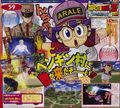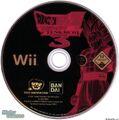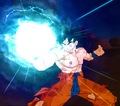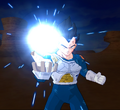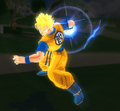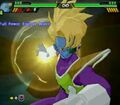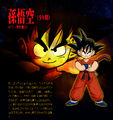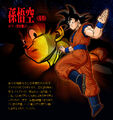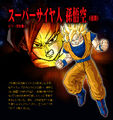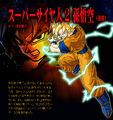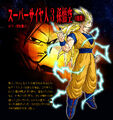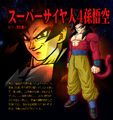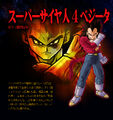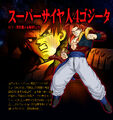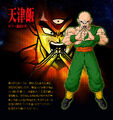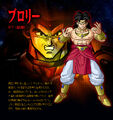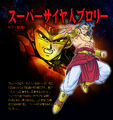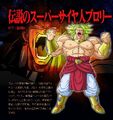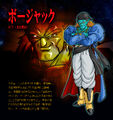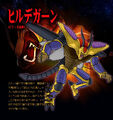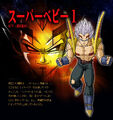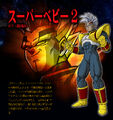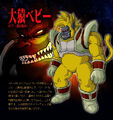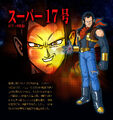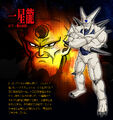Dragon Ball Z: Budokai Tenkaichi 3, originally published in Japan as Dragon Ball Z: Sparking! METEOR (ドラゴンボールZ Sparking! METEOR) in Japan, is the third installment of the Budokai Tenkaichi series. The game was released for the PlayStation 2 and Wii on October 4, 2007 in Japan (in some regions, the Wii port saw a delay). The PlayStation 2 version was released on November 13, 2007 in North America and on November 9, 2007 in Europe. The Wii version was later released on December 3, 2007 in North America and on February 15, 2008 in Europe.[1]
Overview
Like its predecessor, despite being released under the Dragon Ball Z label, Budokai Tenkaichi 3 essentially touches upon all series installments of the Dragon Ball franchise, featuring numerous characters and stages set in Dragon Ball, Dragon Ball Z, Dragon Ball GT and numerous film adaptations of Z. The game also features one of Akira Toriyama's original characters, related to Dragon Ball through crossovers, Arale Norimaki from Dr. Slump.
Gameplay
Budokai Tenkaichi 3 features 161 characters, almost the largest in any fighting game; being topped by Tobal 2, for which Akira Toriyama was a designer. Ryo Mito stated that the game would feature never-before-seen characters made exclusively for the game, referring to the Saiyans' Great Ape forms.[2] Gamestop offered an exclusive version with a bonus DVD containing the top 10 television series battles as voted by fans on the release date.
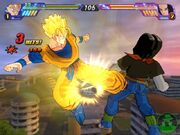
Future Gohan vs. Android 17
Several new notable features include: Battle Replay, night and day stages, the Wii's online capability, and Disc Fusion. Battle Replay allows players to capture their favorite fights and save them to an SD card to view later on. Night and day stages allow for more accurate battles in Dragon History, as well as the ability to transform into a Great Ape by using the moon. There are also several other time differences, such as dawn and afternoon. Not all stages provide different times. You can also change the aura of your character. The Wii version features online multiplayer capability, the first game in the series to have such a feature. Players can fight against anyone from around the globe with a ranking system showing the player's current standing compared to anyone else who has played online. As compensation for the lack of online, Spike has added a new "Disc Fusion" system to the PlayStation 2 version. Inserting a Budokai Tenkaichi 1 or 2 disc during play unlocks Ultimate Battle or Ultimate Battle Z, modes featured in the respective games needed to unlock them. The game also supports 480p for both the Wii and the PlayStation 2 versions.
Other features in the game include more combo attacks or character specific combos, the Blast Combos, and the Z Burst Dash. The additional combo attacks will be able to help chain in more attacks for more damage and longer combos. The Blast Combos are normal combos used in the game, however by inputting the another button into the attack will allow you to use a blast attack for extra damage. Depending on the moves of the character you might not be able to use this feat such as Videl or Hercule. The Z Burst Dash is much faster and more evasive version of the Dragon Dash. It allows the user to get behind the opponent at high speeds for either a strike or to avoid a Blast 2 attack. The drawback to this technique is that it will rapidly drain the user of energy unless equipped with certain Z-items.
Game modes
- Dragon History
- Saiyan Saga
- Frieza Saga
- Android Saga
- Majin Buu Saga
- Special Saga (Movies)
- Dragon Ball GT Saga
- Dragon Ball Saga
- What If Saga
- Ultimate Battle
- Sim Dragon
- Mission 100
- Survival
- Disc Fusion (exclusively on the PlayStation 2 version)
- Dragon World Tour
- World Tournament
- World Martial Arts Big Tournament
- Cell Games
- Otherworld Tournament
- Yamcha Game
- Duel
- Single Battle
- Team Battle
- DP Battle
- Battle Options
- Dragon Net Battle (exclusively on the Wii version)
- Custom Battle
- Normal Battle
- Friend Battle
- Ranking Battle
- View Ranking
- Battle Record
- Evolution Z
- Character Customize
- Item Shop
- Item Exchange
- Item List
- Evolution Z Explanation
- Ultimate Training
- Training
- Battle Training
- Data Center
- Password Input Screen
- Fighter Catalog
- Replay
- Character Reference
- Options
- Shenron
New gameplay elements
Several new features have been added to Budokai Tenkaichi 3. These include:
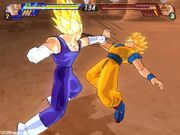
Super Saiyan 2 Goku uses Sonic Sway on Majin Vegeta
- Sonic Sway – This technique allows the player to evade the opponent's attacks. Since it takes longer for the attacker to get back into their fighting stance than it does the player dodging the attacks, the attacker is left with an open defense. The one evading can then quickly counter-attack their opponent. However, this feature only applies to the weak basic melee strikes, the user will still be hit if they attempt to use Sonic Sway on a Rush or Smash attack.
- Rush Ki Wave – A brand new combo finisher exclusive to some characters that allows them to send their opponent flying away with a charged one-handed beam.
- Z-Counter – The ability to block and counterattack by moving quickly behind the enemy. This is a technique seen in the series many times.
- Z Burst Dash – An enhanced version of the dash attack from the previous games, this technique allows players to zig and zag behind the opponent as they move at high speed.
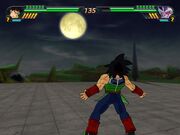
The new night system causes Bardock to transform into a Great Ape
- The addition of a new day and night system allows certain characters to harness the power of the moon to transform into a Great Ape.
- With the addition of the Battle Replay mode, players can now capture up to seven of their favorite fights and watch them again later on. There are also several camera angles that can be used to swap views of the battle: behind the player's shoulder or behind the opponents shoulder. The bars at the top can also be removed for better viewing.
- The Wii version does not make use of the Wii's sensor bar. The game instead uses the Wii Remote's accelerometer which provides animations demonstrating how to perform techniques (much like previous games provide the button combinations that are required to execute a technique).[3]
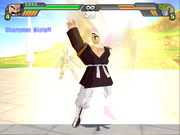
A Battle Replay with the HUD shown
- The game's story mode, called Dragon History, has been completely changed from the previous installments. Some cutscenes take place during the middle of a battle, interrupting the fight for a short time while the two characters talk, while others take place during the battle themselves. During in-game cutscenes, dialogue appears at the bottom of the screen as the player fights, and what each character says depends on how the match is going. The player can also issue one-hit KOs in story mode by dealing the blow used to kill their opponent in the source material. The story mode is also significantly shorter than previous installments (missing battles such as Piccolo vs. Cell, and Gohan vs. Super Buu).
- A new Z-Point system replaces the leveling system from Budokai Tenkaichi 2. The more Z-Points a character has, the more Z-Items can be equipped.
- The Wii port of Budokai Tenkaichi 3 can be played using several different control setups, and is not restricted to the console's Wii Remote and Nunchuk alone. Instead, the player can choose to use the Classic Controller or the GameCube controller, as well. The Classic Controller set up has been best received by critics, whom cite the Wii Remote as a fun method of play for casual gamers, but one that does not always maintain the responsiveness for hardcore gameplay.
Playable characters
Nail
Each character in the game is based on their anime counterparts, their voice actors also partaking in the development of the game whenever possible. Each character has attacks and fighting styles more-or-less derived from the source material, for example Goku's Kamehameha and Vegeta's Galick Gun. Certain fighters also have abilities, or the lack thereof, exclusive only to a small group of characters. Also, certain characters cannot fly in the series, and thus slowly descend back to the ground after taking flight in Budokai Tenkaichi 3 (however, a Flight Z-Item is available for use by these characters, removing this restriction).
King Cold about to slash King Vegeta
The following represents the characters as they are ordered in the Character Select menu. Additional transformations appear in small text directly below the character to which they belong. Some characters are only playable in unabridged transformations, meaning they cannot revert to any preceding forms and are only able to progress in the transformation cycle. For example, Super Saiyan 4 Vegeta, is a character separate from all other incarnations of Vegeta in the game, thus none of these other Vegeta characters can assume the transformation, nor can Super Saiyan 4 Vegeta return to his base form. The character's only transformation option is to progress to Super Saiyan 4 Gogeta. Characters who are only playable in unabridged forms have the title of their transformation listed in parenthesized small text beside their name.
Voice actors
English version
- Andrew Chandler – Cooler, Spopovich
- Bill Townsley – Babidi, Cui, Guldo
- Bob Carter – Bojack, Syn Shenron
- Brad Jackson – King Cold
- Brandon Potter – Alien Announcer, Appule, Earthling 2
- Brice Armstrong – Captain Ginyu, Lord Slug, Senbi Norimaki
- Brina Palencia – Arale Norimaki, Bulla, Chiaotzu, Puar
- Chris Cason – Shu
- Chris Forbis – Dodoria
- Chris Patton – Turles, Earthling 4
- Chris Rager – Hercule, Frieza Soldier 2
- Christopher R. Sabat – Vegeta, Piccolo, Burter, Gogeta, Grandpa Gohan, Jeice, King Piccolo, King Vegeta, Korin, Mr. Popo, Omega Shenron, Recoome, Salza, Porunga, Shenron, Vegito, Yamcha, Zarbon
- Chuck Huber – Android 17, Android 13, Garlic Jr., Super 17, Pilaf
- Colleen Clinkenbeard – Zangya, Mai
- Cynthia Cranz – Chi-Chi
- Dameon Clarke – Cell, Tambourine
- Elise Baughman – Pan
- Eric Vale – Future Trunks, World Tournament Announcer
- James T. Field – Play-by-Play Announcer
- Jason Liebrecht – Tapion
- Jeremy Inman – Android 16
- Jerry Jewell – Nam
- Jim Foronda – Fat Janemba
- John Burgmeier – Tien Shinhan, Saibamen, Frieza Soldier, Nuova Shenron
- Josh Martin – Majin Buu, Kid Buu, Earthling 1
- Justin Cook – Devilman, Raditz, Super Buu
- Kara Edwards – Goten, Gotenks, Videl, Upa
- Kent Williams – Dr. Gero, Elder Kai, Supreme Kai, Super Janemba, Tao
- Kyle Hebert – Gohan, Pikkon, Narrator
- Laura Bailey – Kid Trunks, Dende, Gotenks, Kid Chi-Chi
- Linda Young – Frieza, Baba, Fasha
- Meredith McCoy – Android 18, Launch
- Mike McFarland – Yajirobe, Baby Vegeta, Android 8, Master Roshi, Pui Pui
- Phil Parsons – Nappa
- Phillip Wilburn – Android 19
- R. Bruce Elliot – Dr. Wheelo, Earthling 3
- Rick Robertson – Dabura
- Robert McCollum – Hirudegarn
- Sean Schemmel – Goku, Gogeta, King Kai, Nail, Vegito
- Sean Michael Teague – Uub
- Sonny Strait – Krillin, Bardock, Giru, General Blue
- Stephanie Nadolny – Kid Gohan, Teen Gohan, Kid Goku
- Tiffany Vollmer – Bulma
- Vic Mignogna – Broly
Music
The opening to the game is "Super Survivor" by Hironobu Kageyama in the Japanese and European versions. The American version uses an instrumental version.
Dragon Ball Z: Sparking Meteor features remixed music from the anime, while Dragon Ball Z: Budokai Tenkaichi 3 has original music from Atari.
List of Background Music
- The Meteor
- Vital Burner
- Innocent World - Used in the Shop
- After The Fire - Used in the World Tournament selection screen
- Sweet Vibration
- Survive
- Heat Capacity
- Overture
- Shine
- Power Scale
- Edge of Spirit
- Caution!
- Menace
- Hot Soul
- High and Scream
- Shootout in Meteor
- Dynamite Battle
- Burnin' Up
- Wild Rush
- Evolution
Reception and Sales
The PlayStation 2 port of the game received a 32 out of 40 from the game magazine Famitsu, while The Magic Box ranked the Wii version 33 out of 40.[4] IGN awarded both versions of the game an 8 out of 10, their only complaints being the comparatively underwhelming story mode (in comparison to Budokai Tenkaichi 2), gimmicky Disc Fusion function and the lag experienced while playing online through the Wii's Wi-Fi connection.
The game has sold 4,000,000 units on the PS2 and Wii combined, with the PS2 version selling 3,000,000 units, and the Wii version selling 1,000,000 units, as of June 1, 2014.[5] This makes Dragon Ball Z: Budokai Tenkaichi 3 the best selling Dragon Ball game to date.
Trivia
- If Piccolo enters a tournament, his screen name will be MaJunior, as it originally was in the series. In a similar fashion, the screen name will be Shin if one enters the tournament as Supreme Kai.
- If one waits a while at the menu screen of the story mode, various characters will occasionally show up and engage in a conversation with Goku, such as Piccolo and Krillin.
- When Super Saiyan 4 Goku powers up against Baby Vegeta in story mode, he will sound like Kid Goku (GT).
- If you wait for a while in Duel Mode, Nappa will ask Vegeta: "Hey uh... Think if I went Super Saiyan, my goatee would grow?"
- Saiyan characters that can become Great Apes by creating a Power Ball do so even in stages that have a full moon.
- Bardock is one of the characters that has to use a full moon to turn into a Great Ape, which goes against the Ocean dub of DBZ in which Vegeta says that Bardock invented the Power Ball technique, this was however a major dub mistake that has long since been abandoned.
- Vegeta (Scouter)'s second and third attires have no tail, but he can still transform into a Great Ape.
- Great Ape Vegeta uses his base form's voice when losing an Energy Clash, going into MAX Power, or using rapid movement.
- Like in Budokai Tenkaichi 1 and 2, Cell in any form uses his "Imperfect form" pain sounds when hit. This is however due to the Japanese version having a single voice for Cell, leaving no space to add in extra voice slots for his different form.
- If one fires Android 18's Destructo Disk at Krillin and he uses his as soon as 18's disks are about to make contact, Krillin will summon pink disks instead of his yellow ones.
- Goku's profile says that he fought Pikkon in his Super Saiyan 2 transformation, which did not appear to be the case in the anime. Though they may have fought with Goku in this form during the 7 years between the Cell Saga and Buu Saga, off-camera.
- In the Majin Buu Saga, the Destined Battle: Goku vs. Vegeta, the description says "puroposely" instead of "purposely", even when the voice says "purposely" correctly.
- Majin Buu's Character Introduction says "In Dragon Ball GT, Buu fights against" and ends there, leaving that info missing.
- Gotenks occasionally says "Peanut Butter Jelly Time" when switching out in team battle, as in the famous internet meme.
- Gogeta (Super Saiyan 4) Character Introduction reads "He is a warrior without peer, and demonstrates this by performing this by performing his ultimate move the "Big Bang Kamehameha", repeating the "this by performing".
- When on the character selection, Vegito is spelled with an "I", but on the transformation options for Vegeta (Second Form) and Goku (End), it is spelled "Vegeto".
- Sometimes when Shenron or Ultimate Shenron is about to grant a wish, he will say "That is a wish I cannot grant." Yet, he still grants it.
- In the Wii version of the game, Giru is referred to as both Gill and Giru.
- When Goku (GT) uses the Solar Flare, he says it as it is said in Japanese: "Taiyoken".
- When Goku (GT) uses the Spirit Bomb, it is mistakenly called Spirit Ball, possibly mistranslated due to its original name in Japanese, Genkidama, whose translation is the latter.
- When Baby Vegeta uses the Final Flash, he yells "Big Bang Attack", just like he does in the anime.
- Nuova Shenron is spelled two ways. On the character selection it is spelled Nuova Shenron, but in the GT saga, the subtitles for Goku spell it Nova Shenron.
- When GT Kid Goku turns Super Saiyan 4 against Nuova Shenron in Story Mode, Goku will use his kid voice in the in-game cutscene.
- In Dragon History, during the fight with Nam, Mr. Satan is shown on the signs and blimps even though he was not the champion yet.
- In Chi-Chi's commentary about characters, she says on Grandpa Gohan that she would like to have met him. However, she indeed met him in the last episodes of Dragon Ball. The game might be disregarding this, though, as it was anime-only filler.
- Frieza's move "You Might Die This Time" is mistakenly called "I Might Die This Time". This error is fixed in later games.
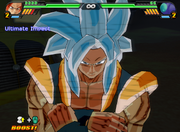
Super Saiyan 4 Gogeta's alternate color
- Super Saiyan 4 Gogeta's 2nd "color" turns his hair silver, which looks similar to the fan-made Super Saiyan 5. This color is also an option for SS4 Gogeta in Dragon Ball Z: Ultimate Tenkaichi.
- Whenever a Great Ape throws a rock, it is spelled "Gigant" instead of "Gigantic".
- When Goku (Mid) uses the 20x Kaio-ken Kamehameha, the technique's name appears spelled "20x Kaiken Kamehameha" on the screen.
- In the Story Mode scenario "Ultimate Super Gogeta", "Saiyan" is spelled as "Siayan" on the subtitles whenever Super Saiyan 4 Vegeta uses a Blast 2 or an Ultimate Blast and says "Can you handle this, a Super Siayan 4?"
- In the scenario "Ultimate Super Gogeta", Pan will say that Goku and Vegeta did Fusion, even before the prompt to fuse appears.
- In the Italian translation of the game, during the intro of the "Dragon Fist Explosion! If Goku doesn't, who will?", the game states that "Goku explodes with a new special attack to stop Majin Buu" when it should say Hirudegarn.
Gallery
Scans
Screenshots
Vegeta facing Broly and Janemba in the opening Great Ape Vegeta charges a Super Galick Gun Great Ape Vegeta fires his Super Galick Gun Vegeta fires his Final Galick Cannon Nail stalls for time Frieza dodges Goku's punch Android 18 uses the Sadistic 18 elbow Android 18 kicks Vegeta Android 18 throws Vegeta away Android 18 turns around in Sadistic 18 Android 18 fires the Sadistic 18 finger beam Cell absorbing Android 18 Cell charging his Solar Kamehameha Zangya Goku dodges Majin Vegeta's Final Impact Uub performs his Blazing Barrage Palm Great Ape Baby fires a Super Galick Gun Super Saiyan 4 Vegeta uses the Final Shine Attack The 100x Big Bang Kamehameha is charged Gogeta fires his 100x Big Bang Kamehameha GT Goku charges his Universal Spirit Bomb GT Goku's Universal Spirit Bomb |
Characters
Goku (GT) Super Saiyan Goku (GT) Super Saiyan 3 Goku (GT) Vegeta (Scouter) Vegeta Majin Vegeta Gogeta Gohan Future Gohan Super Saiyan Future Gohan Chiaotzu Videl Great Saiyawoman King Cold King Vegeta Raditz Great Ape Raditz Nappa Great Ape Nappa Great Ape Fasha Dr. Wheelo Android 13 Super Android 13 Babidi Spopovich Evil Buu Baby Vegeta Nuova Shenron Chi-Chi Nam Android 8 Devilman |
See also
- List of items in Budokai Tenkaichi 3
- List of playable characters in the Budokai Tenkaichi series
- List of stages in Budokai Tenkaichi 3
References
External links
- Dragon Ball Z: Budokai Tenkaichi 3 official website (Japanese)
- Dragon Ball Z: Budokai Tenkaichi 3 at GameSpot
- Dragon Ball Z: Budokai Tenkaichi 3 at GameSpy
- Dragon Ball Z: Budokai Tenkaichi 3 at GamersHell
- Dragon Ball Z: Budokai Tenkaichi 3 at Gamestop


